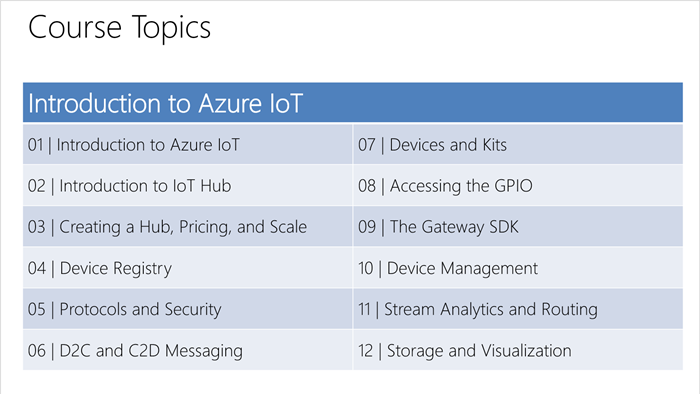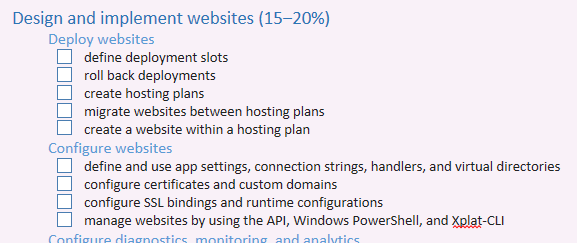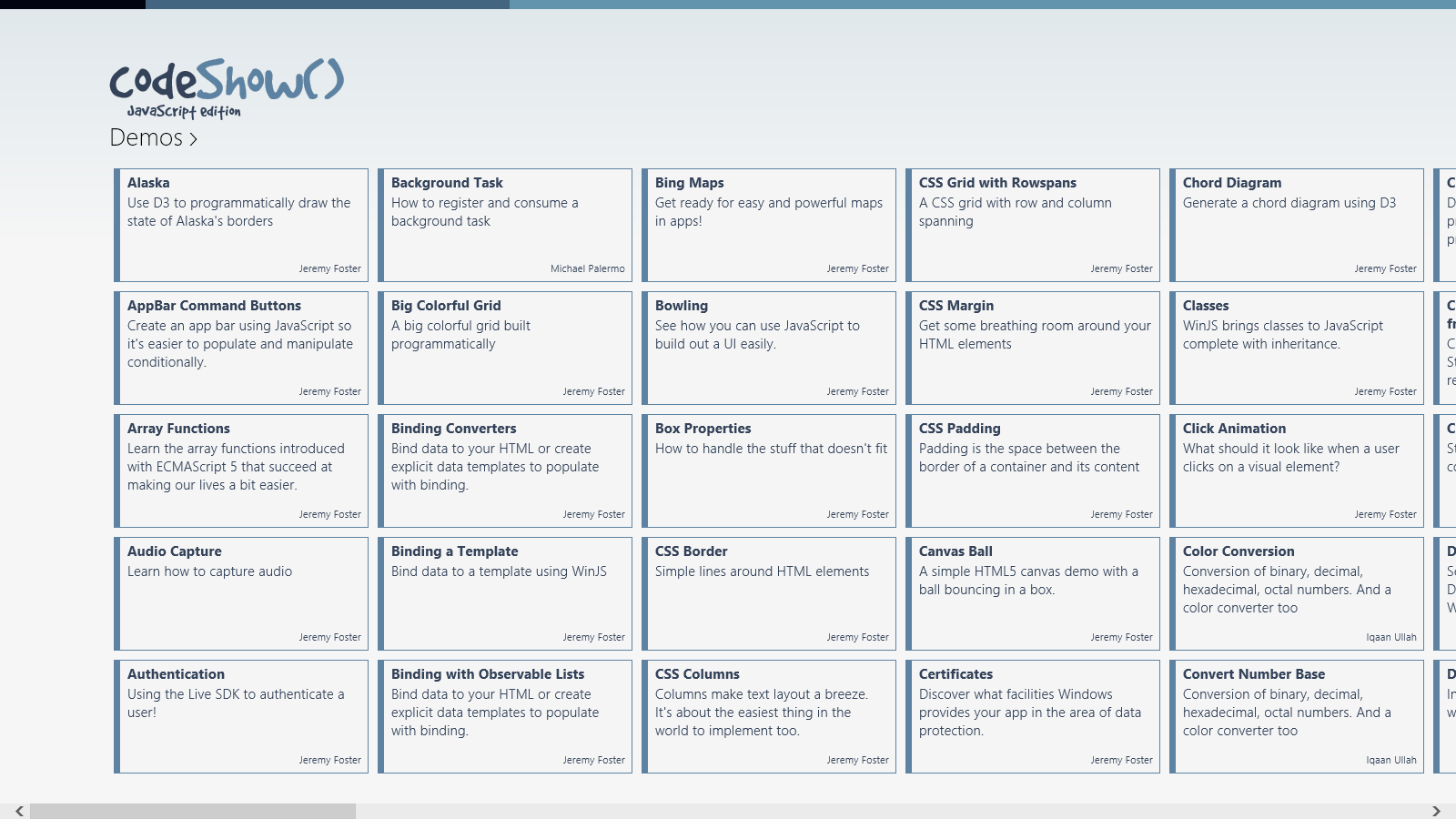Posts tagged with "learning"
Introduction to Azure IoT (an MVA course)
One of my university professors once said that “Software is the most complex creation of man.”
I think I’m drawn to software development and to technology in general precisely because it’s complex. It’s a field I know I’ll never reach the extents of. It will never run up against boundaries with how creative I can be with technology, and I’ll never run out of new concepts to learn.
So that’s what I love to do - to be involved with learning and teaching technology. That’s why I usually say opportunities to present online learning courses.
In April 2017, presented a course on Microsoft Virtual Academy called Introduction to Azure IoT.
The course served to introduce curious viewers to IoT in general as well as to the broad offerings of Azure in the area of IoT, and it also served to introduce viewers to the more in-depth course on the same subject available on the edX platform. Jump over to Developing IoT Solutions Using Azure IoT (DEV225) on edX now.
You can download this PowerPoint deck to get a deeper sense of what was covered as well as to get a reference to the various external links that I used.
Here are the topics…

Hope this helps you ramp up on IoT!
A Developer Community in Boise, Idaho
I’m a sailor. I don’t sail much right now, because I don’t have time, but I still identify as a sailor.
One of the best things about sailing is the marina community. Folks on the docks are amazingly helpful and friendly. You rarely come in to dock without other boaters offering to grab a line and help you land.
There’s good community in software development too. Sure, there are some bad eggs, but overall, the development community is strong. When I meet new developers trying to learn or new graduates trying to land a job, I always recommend they find a few local meetups to visit. Then pick one or two and attend every month.
Before long, they’re rubbing shoulders with other developers, learning things, figuring out what the web front-end flavor of the week is, and even finding new job roles.
Boise, Idaho has a strong developer community in the Boise .NET Developers User Group (NETDUG).
I fly out to Boise now and then to teach and learn from these fine folks who are fortunate enough to live and work in a beautiful area of the country while still working software development jobs.
Last night I talked to the group about the Microsoft Bot Framework in a session I called Bring on the Bots.
As I told the group, I was none too excited about bots when they were first mentioned at Build 2016, but I’ve since seen the future and realized that digitizing conversation is going to be a big part.
So, here’s to all the software developers in Boise and specifically those in NETDUG. And here’s to NETDUG leaders like @TheScottNichols and @brianlagunas.
If you’re anywhere near Boise, Idaho in March, do know that the Boise Code Camp is a real blast and pretty much a requisite for coders of all breed.
There’s also a Visual Studio 2017 Launch Party the morning of March 9 at the Microsoft office that you’re all welcome too. Hurry because space is limited.
Microsoft Exam 70-532 Study Guide
I’m currently studying for Microsoft exam 70-532 - Developing Microsoft Azure Solutions. I do enjoy studying for exams. It’s hard, but it’s an excellent forcing function. I learn bits and pieces here and there now and then about this and that, but when I have an exam schedule for a set date, I have to study! And not only do I put in more hours, but I follow a more systematic approach. In this article, I’m going to share my approach and give you my study guide for exam 70-532 in case you too are studying and this method works for you.
Here’s my strategy…
Visit the official exam page
For 70-532, the page is at https://www.microsoft.com/learning/en-us/exam-70-532.aspx
Click show all under the Skills Measured section and copy the whole thing
Paste it into a OneNote notebook
Format it by breaking all of the skill points out onto separate lines and adding checkboxes
Study each point and check it off when I feel like I understand
Here’s what it ends up looking like when I’m done…

So I start by asking myself if I know what a _deployment slot _is. I don’t. I Bing it and find something like this Staged Deployment on Microsoft Azure Websites article that does an excellent job of defining the term and goes on to discuss the next point roll back deployments as well. So I read up, try it myself, grok the concept, then check the boxes. Simple as that. Notice I said that my study process is simple. The concept aren’t always, but then that’s one of the reasons I like software… it’s complicated!
So attached you’ll find a OneNote notebook that’s yours to keep. Just open it up, start studying, and start checking. And give me a shout on Twitter when you pass the exam! Best of luck!
codeShow
codeShow is a app for learning to make apps. It’s very meta in that way. The whole project is an open source project with community contributions. Use it to learn the web platform and Windows app development.
You can download the app by visiting aka.ms/codeshowapp and you can find the source code at codeshow.codeplex.com.

MCSD HTML5 Exam Offer
It’s was a big day in Building 33 as 100 or so people gathered to write Windows 8 apps, compete for prizes, and hopefully learn a little something along the way. One of the things attendees learned was that Microsoft Learning (MSL) is really rockin’ the Microsoft certifications lately. Paul Lee joined us at the hackathon to talk about the state of Microsoft certifications. They have tracks that based on software solutions and the technologies a developer would use to create them.
The one I’m excited about is the MCSD: Windows Store Apps - HTML5. Which you can earn if you take the 70-480, 70-481, and 70-482 exams. And actually, the first of those exams is free (for now) if you go to http://www.register.prometric.com to schedule your exam and use HTMLJMP as your promo code. If you want help studying for 70-480 and 70-481, you can take a look at the JumpStart videos that Michael Palermo and I recorded at http://aka.ms/jump480 and http://aka.ms/jump481.
Attached are the slides that Paul presented.
Get An App Into the Windows 8 Store
As you likely know Windows 8 is coming in the near future. You can download, use it, and even develop apps for it today. At this point in time, the Windows Store is not open for everyone to deploy, but we are looking for the first wave of great applications which highlight the power of Metro and Windows 8, especially those developers that want to get to market first and build the awareness and brand for their applications.
In order to submit your application today, you need a token which is something I can help you get.
What do you need to do to get a token? Here are the key steps:
- Create a great application or game and get it ready.
- Let me know about it by contacting me via
jeremy.foster@microsoft.com - I’ll help you register so you can get your application through our Application Accelerator Labs where the app will get reviewed to confirm it is done and conforms to the Metro guidelines and certification requirements.
This is a great opportunity to not only be first to market with your app, but also to get feedback from a Microsoft Services Engineer to make your app great. If you are serious about creating an application this is a chance that you probably don’t want to pass up.
In addition, our team is holding a series of events and office hours to help you - we want to make sure you have what you need to be successful. You can come learn more about how to build apps for Windows 8 or show up and build your app with one of our evangelists or others in your community available to help you if you need it. You can find more information about our events and availability at…

Windows 8 Developer Camps
Windows App Accelerator Labs
Los Angeles, CA (May 8-10)
Inline Count in the OData Spec
When it comes time to tackle a new (to you) technology, how do you begin? Do you read others’ experiences from blogs? Wait for screencast instructions from a site like Pluralsight?
There are a lot of ways to learn, but I’m reminded of the value of just going back to the spec. Sometimes the author of the blog article you’re reading is in your same boat trying to learn, and going directly to the spec, you might get to bypass a lot of wasted trial and error cycles.
I’ve spent a lot of time in the HTML5 spec the last while, and somewhat recently also the OData spec (which you can find at odata.org). I’ve read a lot of blogs and seen a lot of videos on the subject of OData, but when I finally found my way to the actual spec, I was pleased to find a very concise and obviously thorough coverage of the topic.
One of the little things I learned which has big implications for me is the ability to specify a query option called $inlinecount. With this query option specified, an OData query will bring back a count of all entities in the queried collection (applied after any filters) even if some limiting options such as paging or $top are included.
Take, for example, the following query…
http://services.odata.org/OData/OData.svc/Products?$inlinecount=allpages&$top=10&$filter=Price gt 200 |
The query should find the first 10 products whose price is greater than 200. If you’re retrieving these products to be displayed in a web page, however, and you need to worry about paging and you need to tell the pager how many pages to render, you’re going to need to know the **total **number of products that with a price greater than 200 even though this query only asks for the top 10 (don’t use $top for your paging, BTW, there’s a better way). The inclusion of inlinecount, in this query dictates the inclusion of the following element in the response…
<m:count>24</m:count> |
With this additional information about the submitted query’s results, your pager now knows to render 3 pages (of 10).
Notice that the Price gt 200 filter did get applied before the result for inlinecount was calculated, so we did not receive back an inline count of all product entities.
This is certainly just a shallow glance at the topic. If you want more in-depth information about OData or about the inlinecount query option, you should go straight to the spec :)